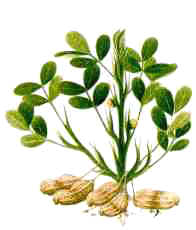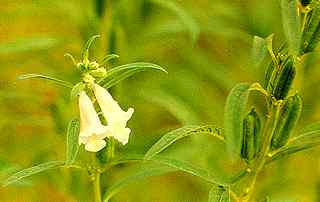
SEVEN IMPORTANT OILS
1 – Arachis or peanuts seeds reached in the world the mark of 5.2 million tonnes during 2011/12. The main productors are China (37% of the world crop and 32% for oil), India (25%), USA (5%), and various African states (Sudan, Senegal, Nigeria).

The probable centers of origin of Arachis species and A. hypogaea were in the Gran Pantanal (Mato Grosso, Brazil) and on the eastern slopes of the Bolivian Andes. The Incas cultivated this plant since 3000 B.C., but it was known in Europe only after the discovery of America. From Europe, peanuts were exported by the Portuguese and Spanish explorers over the rest of the world (Africa, China, Philippines, Cuba). Peanut seeds make an important contribution to the diet in many countries. They are a good source of proteins, lipids, and fatty acids for human nutrition. They are rich in oil, naturally containing from 47 to 50%.
It has a high oleic content, which is associated with good oxidative and frying stabilities. It is a non-drying oil that solidifies from 0 to 38°C.
About 96% of peanut triacylglycerols are composed of palmitic, stearic, oleic and linoleic acids. Cultivars from various countries presented the following fatty acid distribution: C16:0 = 9.3â13.0%, C18:0 = 1.1â3.6%, C18:1 = 35.6â58.3%, C18:2 = 20.9â43.2%, C20:0 = 0.3â2.4%, C20:1 = 0.7â3.2%, C22:0 = 1.8â4.4%, and C24:0 = 0.4â 1.9%. Additional compositional data may be found in a review article (Carrin ME et al., Eur J Lipid Sci Technol 2010, 112, 697).
The composition in triacylglycerol species is characterized by the presence of OOO (27%), OOL (18%), POO (17%), PLO (12%), OLL (11%) (Cunha SC et al., Food Chem 2006, 95, 518).
2 – Cotton, 5.3 mt oil in 2011/12. The plant is cultivated mainly for fibers. The first producer of cotton fiber was in 2005 China (24%, 33% for oil), followed by USA (19%), India (15%), Pakistan (8%), Brazil (6%).

Cotton (Gossypium hirsutum, Malvaceae) is probably known since 3000
B.C. Around 600 B.C., cotton came from India to Egypt and was brought in Europe by Alexander the Great (330 B.C.). This species contributes about 90% of the world production of fiber. The cotton oil was mentioned by Herodot (450 B.C.) but its worldwide use was born only in the 19th century. The kernel comprises about 50% of the seed and contains about 30% of oil. The world production of cottonseed was in 1999 about 36 million tons. About 97% of triacylglycerols are composed of palmitic (22%), oleic (18%) and linoleic (57%) acids. The composition in triacylglycerol species is characterized by the presence of LLP (29%), LLL (17%), OLL (14%), OLP (12%), and PLP (8%) (Lisa M et al., J Chromatogr A 2008, 1198-1199, 115).
Cotton oil is characterized by its content in gossypol, a phenolic pigment involved in its storage stability, and in cyclopropenoid fatty acids which give the distinctive red color of that oil.
The entire production of cotton oil is used in the manufacture of salad and cooking oils, shortenings and margarine, and to a lesser extent to produced soaps.
3 – Coprah from coconut (Cocos nucifera, Palmae), 3.6 mt oil in 2011/12.
Coconut palms are known to have been used in India since 500 B.C., the Spanish name coco dating from around 1500. Its origin is a subject of dispute, South America or Southeast Asia. Coconut palm known as "tree of life" is one of the most useful trees in the world. Population of humid tropical regions is almost entirely dependent on coconut as a source of food, fuel and shelter. In the 19th century the tree was used in Europe quite exclusively for the fibers. Plantations of palms begun at the end of the 18th century in Sri Lanka with the Dutch and Portuguese colonization.
About 5000 nuts are needed to produce one ton of coprah (dried kernel) which has a fat content of about 65%, the whole fruit giving about 23% oil. As the lauric acid content is high (up to 52%), this oil belongs to the group of "lauric oils". The world production of coconuts was in 1999 about 49 million tons, Indonesia producing 30%, Philippines 23% and India 21%. In 2011, the major usages of coconut oil are for food industry (50%), and oleochemicals (47%).
In the coconut-growing countries, it is widely used for domestic consumption as cooking and frying oil. In western countries, it is largely used in the manufacture of margarine, to a lesser extent as ice cream fat, filling cream and confectionery oil. Besides its food uses, it has applications in cosmetics, soaps, detergents and shampoos. Glycerol produced from coconut is extensively used for several industrial applications (cosmetics, pharmaceuticals, explosives, paints). Recently, it has also found usage in the processing of biodiesel. A typical fatty acid distribution of coconut oil is : 12:0 (La): 37%, 14:0 (M): 19%, 8:0 (Cy): 15.6%, 18:1 (O): 11%, and 16:0 (P): 7% . The composition in triacylglycerol species is characterized by the presence of MLaCy (15%), LaLaCy (13%), PLaCy (8%), LaOCy (6%), SLaCy (5%) and MMCy (5%) (Lisa M et al., J Chromatogr A 2008, 1198-1199, 115).
4 – Palm kernel oil, 5.8 mt in 2011/12, in Malaysia, Indonesia and Africa. The first producer is Malaysia (52%), the second being Indonesia (28%). Statistics of world supply and consumption may be found in a specialized web site.
Oil palm (Elaeis guineensis Jacq.) produces fruit which consist of a hard kernel (seed) inside a shell (endocarp), which is surrounded by a fleshy mesocarp. The mesocarp contains about 49% palm oil and the kernel about 50% palm kernel oil. Palm Kernel Oil is yellowish in colour and has a fatty acid composition different from that of palm Oil. Palm Kernel Oil contains mainly lauric acid (C12:0) and more than 80% saturated fatty acids. Palm Kernel Oil closely resembles Coconut Oil in its fatty acid formulation and characteristics, therefore is a cost effective substitute for Crude Coconut Oil in the production of quality soap. As this oil is rich in lauric acid, it is used in the synthesis of lauryl alcohol for detergent industry. The composition in triacylglycerol species is characterized by the presence of LaLaLa (22%), LaLaM (17%), LaMM (9%), LaLaO (6%), and CCLa (6%) (Chen CW et al., Food Chemistry 2007, 100, 178).
5 – Maize, Indian corn or corn (Zea mays), 2 mt
oil in 2004-05. Cultivated in temperate regions, this plant is used accessorily for oil production.

Maize is one of the plants the most anciently cultivated by human, it originated probably from Central America (Mexico, New Mexico) where Indians used it since thousand years. Christopher Columbus brought in Spain some maize seeds from his first exploration (1493) and, through Italy, the plant was spread in the whole Europe. Whereas the total world production of corn amounted to about 600 million tons in 1999, the corn oil production is very low, about 400,000 tons. Corn seed has a maximum total oil content of 12% in some varieties used for starch production. Triacylglycerols comprise about 80%, phospholipids about 8% and glycolipids about 2-5%. Corn oil is rich in tocopherols (up to 1 g per Kg), which account for its excellent stability.
About 60% of corn oil is consumed as salad and cooking oil, the other use (30%) being for manufacture of margarine. A very small proportion is used for some industrial purposes (pharmacy, cosmetics).The composition in triacylglycerol species is characterized by the presence of POO (19%), OOL (18%), OOO (17%), OLL (15%), PLO (13%), SOO (8%) (Cunha SC et al., Food Chem 2006, 95, 518).
6 – Olive (Olea europea), 3.3 mt oil in 2011/12.

Olive trees, originating from Asia Minor, characterize the Mediterranean civilization since thousand years. Olives are mentioned several times in the Bible. It is thought that they appeared in Europe around 1700 B.C. but were spread over the Roman Empire around 200 B.C. The oil content of the whole olive is about 30% but only 20% of the tonnage of fruit can be extracted by pressure. The world production of fruit was in 1999 about 14 million tons, Spain having the highest crop (32%), followed by Italy (19%), Greece (14%) and Turkey (11%). There is an increasing interest in growing this oil in USA and in Australia.
The amount of olive oil available varies from year to year and fluctuates from 1.4 to 2 million tons from 1960 to 1995. In 2003-2004, 79% of the world production of olive oil are expected to be located in the European Community (about 2 million tons), 6% in Tunisia, 5% in Turkey, 4% in Syria, 2% in Morocco, and 1% in Algeria.The fruit or drupe is similar to that of a cherry and is the raw material for the production of olive oil and table olives.
The pulp is rich in oil (75% on dry weight basis), the kernel containing only 12-28% oil. Olive oil is known to contain a large proportion of oleic acid (53-86%). Combined with its natural antioxidants, this high content in oleic acid gives to olive oil an exceptional stability.
Many studies were devoted to the physical and chemical changes of the olive fruit, both during development and as a result of the processing to produce table olives (Review in : Bianchi G, Eur J Lipid Sci Technol 2003, 105, 229).
Good-quality olive oil is mainly used for edible purposes, the rest being used in industry (soap, textile, cosmetics, pharmacy).The composition in triacylglycerol species is characterized by the presence of OOO (61%), POO (20%), OOL (12%) (Cunha SC et al., Food Chem 2006, 95, 518).
7 – Sesame (Sesamum indicum, Pedaliaceae), world crop: 0.8 mt oil in 2004-05.

It is thought that this plant was used by the Persians since about 4000 B.C. Sesame oil was used as a remedy and as a cosmetic (Homer reported in Iliad that the goddess Hera spread abundantly sesame oil on her skin before she seduced Zeus). The primary center of origin could be the Fertile Crescent or the Indian sub-continent. The plant is cultivated in tropical to temperate zones, from 40°N to 40°S latitude. India is the major producer (ca. 25% of the world production). Sesame seeds are used whole, or processed for oil and meal. Whole seeds are used to prepare candies and halva, in baking, soup, and porridge. Sesame seeds have a high oil content (about 50%) but crops are heavily variable. The oil contains ca. 10% palmitic acid, 4% stearic acid, 47% oleic acid and 39% linoleic acid, is expensive and used for culinary purposes mainly in countries of production. Its good conservation capacities is due to the presence of a potent antioxidant, sesamol, release from sesamolin upon hydrolysis by storage. The oil is also used as a solvent or carrier for medicine and cosmetics. The world production of sesame seeds was in 1999 about 2.4 million tons, India having the highest crop (27%), followed by China (21%), Sudan (9%) and Myanmar (Burma) (8%).
The composition in triacylglycerol species is characterized by the presence of OOL (17%), PLO (15%), OLnL (14%), OOO (14%), POO (14%), OLL (10%), LLL (8%) (Cunha SC et al., Food Chem 2006, 95, 518).
To learn more on the fatty acid composition (weight percent) of these plant oils :
Devenez membre et participez au développement de la Lipidomique au XXIème siècle.
S'inscrire